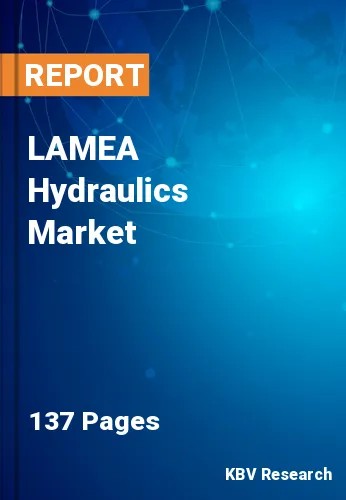The Latin America, Middle East and Africa Hydraulics Market would witness market growth of 5.0% CAGR during the forecast period (2023-2030).
Integrating the Internet of Things (IoT) and Industry 4.0 principles transform hydraulic systems into smart, interconnected components. Sensors and data analytics allow for real-time monitoring, predictive maintenance, and improved overall system efficiency. The push for sustainability and energy efficiency has led to the development of electrified hydraulic systems. By combining electric drives with hydraulic components, manufacturers aim to reduce energy consumption and environmental impact while maintaining the benefits of hydraulic power. Ongoing research and development efforts focus on enhancing the materials and design of hydraulic components. Lightweight and durable materials and innovative design approaches contribute to more efficient and reliable hydraulic systems.
Energy efficiency is a key consideration in designing and implementing hydraulic systems. Variable speed drives, regenerative systems, and other energy-saving technologies are gaining prominence to minimize environmental impact and operational costs. Electro-hydraulic actuators are gaining popularity as alternatives to traditional hydraulic actuators. These actuators offer improved controllability, precision, and responsiveness by combining electric and hydraulic technologies. The growing demand for automation in various industries drives the adoption of hydraulic systems in robotic applications. Hydraulic actuators provide the high forces required for robotic movements in manufacturing, logistics, and other sectors.
As per the Brazilian National Agency for Petroleum, Natural Gas, and Biofuels, Brazil owns the largest recoverable ultra-deep oil reserves, with 97.6% of Brazil's oil production produced offshore. The 2022 average oil production was 3.02 million barrels per day, 2.47% higher than the previous annual record. Hydraulic systems power various machinery and equipment on offshore platforms. This includes cranes, winches, and lifting systems for handling heavy loads and conducting maintenance and construction activities. Thus, the above aspects will expand the market growth across the region in the upcoming years.
The Brazil market dominated the LAMEA Hydraulics Market by Country in 2022 and would continue to be a dominant market till 2030; thereby, achieving a market value of $1,461.7 million by 2030. The Argentina market is exhibiting a CAGR of 5.5% during (2023 - 2030). Additionally, The UAE market would experience a CAGR of 4.7% during (2023 - 2030).
Free Valuable Insights: The Worldwide Hydraulics Market is Projected to reach USD 54.9 Billion by 2030, at a CAGR of 3.7%
Based on End User, the market is segmented into Construction, Aerospace, Metal & Machinery Manufacturing, Mining, Material Handling, Agriculture, Marine, Oil & Gas, Automotive, and Others. Based on Type, the market is segmented into Mobile, and Industrial. Based on Component, the market is segmented into Cylinder, Motor & Pumps, Transmission, Valves, Filters, Accumulators, and Others. Based on countries, the market is segmented into Brazil, Argentina, UAE, Saudi Arabia, South Africa, Nigeria, and Rest of LAMEA.
By End User
By Type
By Component
By Country
Our team of dedicated experts can provide you with attractive expansion opportunities for your business.

